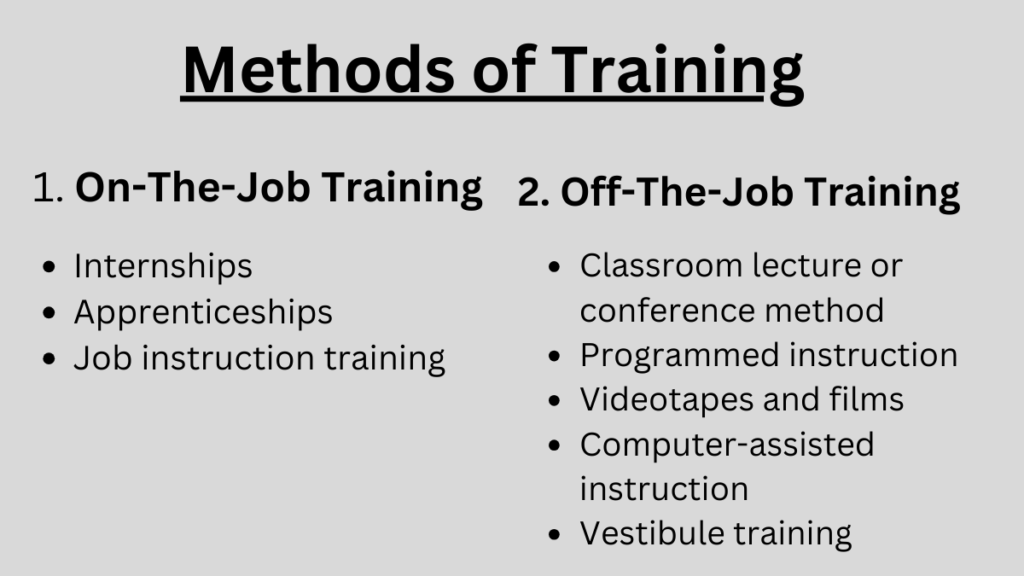Training is an important part of Human Resource Development efforts in modern organizations. It is a process of learning experience that seeks a relatively permanent change in an individual which will improve his or her ability to perform on the job. It is the organized procedure by which people learn knowledge and skills for a definite purpose. It should be considered as the essence of HRD. An organization must go through the training needs and assessment process.
According to DiCenzo and Robbins, “Training is a learning experience in that it seeks a relatively permanent change in an individual that will improve his or her ability to perform on the job.”
According to Dale S. Beach, “Training is the organized procedure by which people learn knowledge and skills for a definite purpose.”
Thus, It can be concluded that it is a process that tries to improve skills or add to the existing level of knowledge so that the employee is better equipped to do his present job or to mold him to be fit for a higher job involving higher responsibilities. It helps to increase performance and aids to effective performance. Performance refers to the function of ability, motivation, and opportunity. The ability of the employee to perform and asses the training need requires the analysis of an entire organization (people, jobs, technology, and so on) to identify trouble spots, and the program is conducted only when it is felt that they can help in solving specific operational problems.
Methods of Training

On-The-Job Training
On-the-job-oriented training methods. As the name denotes, methods included in this cluster are those whose main objectives are centered around the job, i.e., learning on the job by various methods. The main methods, which fall into this category, are discussed here under:
Internships
An internship is a form of on-the-job training that combines job instruction with classroom instruction in trade schools, high schools, colleges, or universities. It binds the theoretical knowledge with practical application which helps trainees to get “real world” exposure and provides an opportunity for a further addition of qualification in the bio-data and a chance to examine a possible employer closely.
Apprenticeships
An apprenticeship program provides an employee with on-the-job experience under the guidance of a skilled and certified worker. Apprentice programs are provided for skill-need employees. The training is mandatory to get a job in the market. The various skills that can be imparted from apprentice training include nursing, plumbing, electricians, work, carpentry, etc.
Job instruction Training
This is a systematic practice technique designed to guide for giving on-the-job skills to blue-collar employees as well as technicians. This method can be adapted to train employees on and off the job. Job instruction techniques include four steps i.e. to select the trainer and trainee carefully to exchange and follow their experience; to explain fully to the trainee about different facts of the job, to undertake a trial performance by the trainee under the guidance of the trainer and provide feedback by a trainer on the performance of the trainee.
Off-The-Job Training
This training takes place outside the job situation. Under this, training is separated from the job situation. Some of the off-the-job training methods are as follows:
Classroom lecture or conference method
A lecture or talk given by the trainer before a group to convey information is an efficient method of reaching large numbers of trainees in a short time. The trainer discusses theoretical aspects of information related to the job. The effectiveness of this program will be to maximize the chances for exchanging ideas and views between trainers and trainees.
Programmed instruction
This is a method of self-instruction in which training material is presented in small forms of information. The information is structured in such a way that the trainee proceeds in a step-by-step sequence from the basic elements of a skill or concept to the more difficult materials. The trainees have to learn step by step following the instructions provided by the instructor. This training method is very useful to impart specific skills, such as photography skills, making financial statements at the end of the month, and learning to fill in sales report forms.
Videotapes and films
The tools are very useful to teach skills to the trainee. Videotapes and films can be used and reused during the training program repeatedly. Films and tapes provide a live-work situation, which is not possible through other methods. The firms can develop such tapes and films for mutual users and benefits. However, the effectiveness of this method depends on how closely such films are related to the specific learning objectives.
Computer-assisted instruction
Some computer software programs are available for learning and teaching trainees different job skills. The use of programs informs trainees about the accuracy, sequence, and method of performing work. Under this method, all instructions are provided by the computer so the trainees must understand the use of the computer and follow its instructions.
Vestibule training
This training takes place in an area away from the real workplace. In this program trainees’ further workstations, including the machine that will be used in the further are duplicated. This method is useful for those trainees who have little or no knowledge of the job situation as the training is directed to provide basic skills and practices of the job to the trainees.
